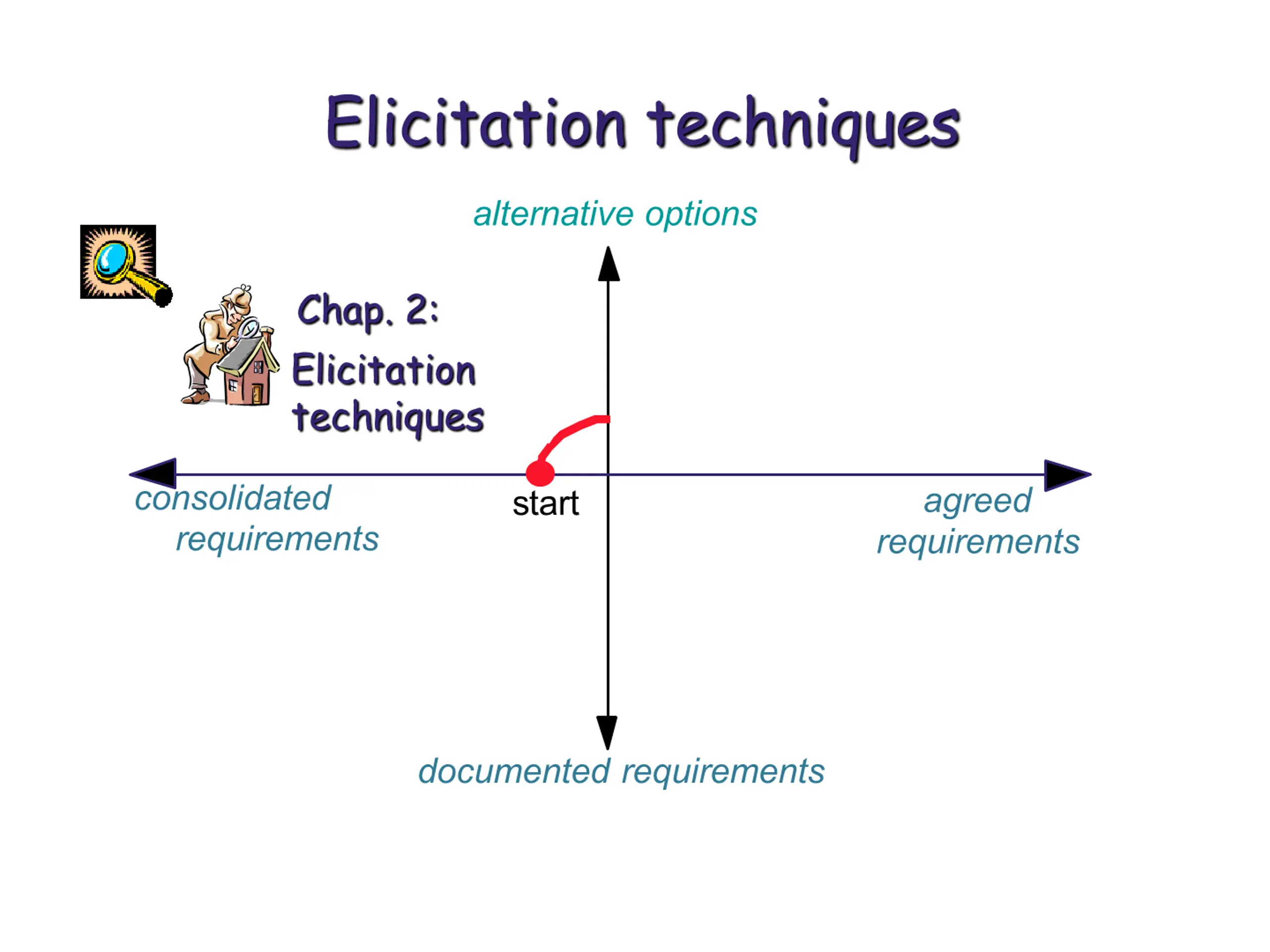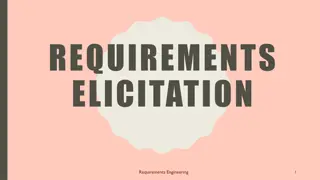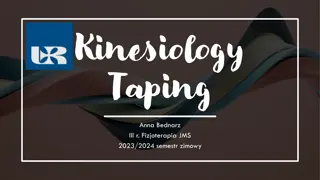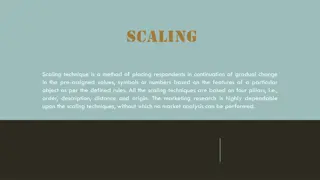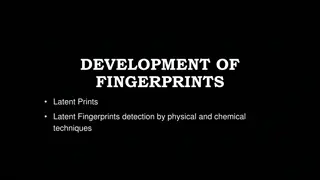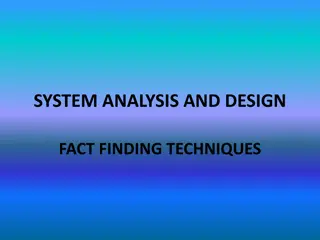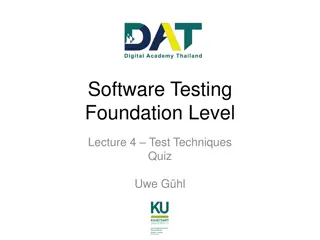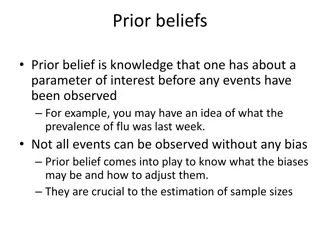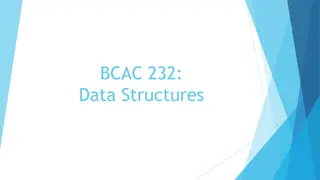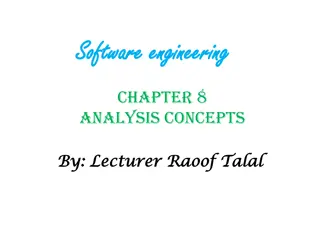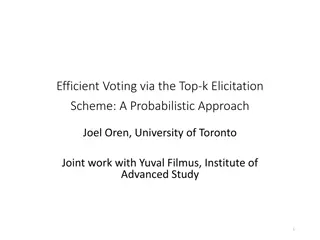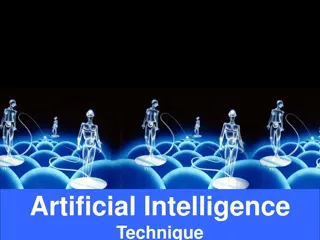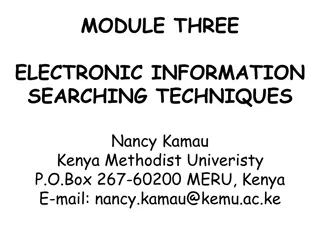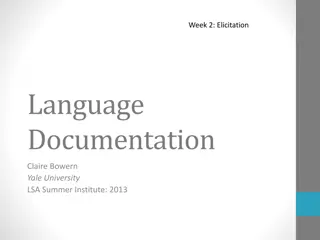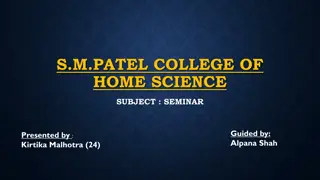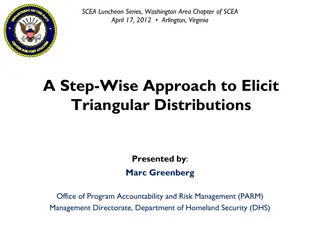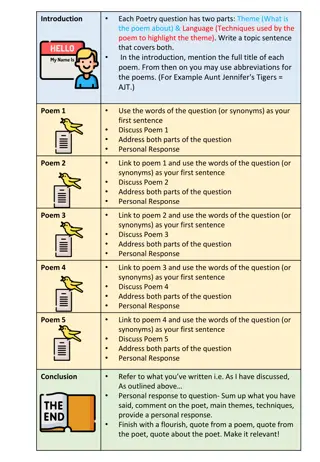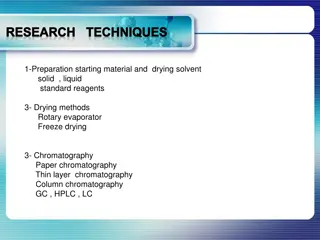Elicitation techniques
An outline of the requirements engineer's non-technical skills, including analytic thinking, empathy, communication skills, conflict resolution skills, and moderation skills.
Download Presentation

Please find below an Image/Link to download the presentation.
The content on the website is provided AS IS for your information and personal use only. It may not be sold, licensed, or shared on other websites without obtaining consent from the author.If you encounter any issues during the download, it is possible that the publisher has removed the file from their server.
You are allowed to download the files provided on this website for personal or commercial use, subject to the condition that they are used lawfully. All files are the property of their respective owners.
The content on the website is provided AS IS for your information and personal use only. It may not be sold, licensed, or shared on other websites without obtaining consent from the author.
E N D
Presentation Transcript
Elicitation techniques alternative options Chap. 2: Elicitation techniques consolidated requirements agreed requirements start documented requirements
outline Requirements Engineer (non-technical skills) Requirement Elicitation Requirements Sources Stakeholders & their significance Handling stakeholders in the project Requirements Categorization according to the Kano Model Elicitation Techniques Support Techniques summary
Requirements Engineer (Non- Technical Skills)..1 Analytic thinking: He/she Must be able to become familiar with domains that are unknown to her/him. He/she Must understand and analyze complicated problems and relationships. Empathy: He/she have good intuition and empathy for people in order to identify the actual needs of a stakeholder. He/she must identify problems that might arise in a group of stakeholders and act accordingly.
Requirements Engineer (Non- Technical Skills)..2 Communication skills: To elicit and interpret the requirement correctly: He/she must be able to listen, ask the right questions at the right time, notice when a statement does not contain the desired information, and make further inquiries when necessary. Conflict resolution skills: Different opinions of different stakeholders can be the cause of conflicts during requirements engineering. He/she must identify conflicts, mediate between the parties involved. He/she apply techniques suitable to resolving the conflict.
Requirements Engineer (Non- Technical Skills)..3 Moderation skills: The requirements engineer must be able to mediate between different opinions and lead discussions. This holds true for: - Individual conversations - Group conversations - Workshops. Self-confidence: He/she needs a high level of self-confidence and the ability to defend herself should strong objections to him/her opinions arise. He/she should never take criticism personally.
Requirements Engineer (Non- Technical Skills)..5 Illustrates a partial snap shot of an online job description example of software requirements engineer Illustrates a partial snap shot of an online job description example of software requirements engineer
REQUIREMENTS ELICITATION The heart of requirements development is elicitation Elicitation is the process of identifying the needs and constraints of the various stakeholders for a software system Elicitation includes activities discovering, extracting, and defining requirements. Elicitation is used to discover business, user, functional, and nonfunctional requirements, along with other types of information. Requirements elicitation is perhaps the most challenging, critical, and communication-intensive aspect of software development. To facilitate clear communication, use the vocabulary of the business domain instead of forcing customers to understand technical jargon. related to collecting,
REQUIREMENTS SOURCES There are three different kinds of requirements sources: 1. Stakeholders are people or organizations that (directly or indirectly) influence the requirements of a system. Examples of stakeholders are users of the system, operators of the system, developers, architects, customers, and testers. 2. Documents often contain important information that can provide requirements. Examples of documents are universal documents, such as standards and legal documents, as well as domain- or organization-specific documents, such as requirements documents and error reports of legacy systems. 3. Systems in operation can be legacy or predecessor systems as well as competing systems. By giving the stakeholders a chance to try the system out, they can gain an impression of the current system and can request extensions or changes based on their impressions.
STAKEHOLDERS AND THEIR SIGNIFICANCE(1) Significance of stakeholders Identifying the relevant stakeholders is a central task of requirements engineering. For the requirements engineer, stakeholders are important sources of requirements for the system. It is the task of the requirements engineer to gather, document, and consolidate the partially conflicting goals and requirements of different stakeholders.
STAKEHOLDERS AND THEIR SIGNIFICANCE(2) Consequences of unconsidered stakeholders If stakeholders are not identified or not considered, it may result in significant negative for the project progress because requirements may remain undetected. At the latest, these overlooked requirements will enter the picture in the form of change requests during system operation. Fixing these issues retroactively causes high additional costs. Therefore, it is essential to identify all stakeholders and integrate them into the elicitation procedures.
STAKEHOLDERS AND THEIR SIGNIFICANCE(3) Stakeholder lists provide overview: An auxiliary technique for stakeholder identification is maintaining checklists. The starting point for stakeholder elicitation is often suggestions of relevant stakeholders that are made by: 1- management. 2- domain experts. On the basis of these suggestions, relevant stakeholders can be identified.
HANDLING STAKEHOLDERS IN THE PROJECT(1) Managing stakeholders It can often be observed in practice that a lot of stakeholders are involved in complex and difficult projects. Due to limited resources, the stakeholders that are the most suitable for requirements elicitation must be carefully selected. To document the stakeholders in the development process, it makes sense to use tables and spreadsheets that contain (at least) the following data: name, function (role), additional personal and contact data, temporal and spatial availability during the project progress, relevance of the stakeholder, area and extent of expertise of the stakeholder, and the stakeholder s goals and interests regarding the project.
HANDLING STAKEHOLDERS IN THE PROJECT(2) Obligations and privileges of the stakeholders A number of obligations and privileges result from the agreement with the stakeholders. The requirements engineer speaks the language of the stakeholders, becomes thoroughly familiar with the application domain, creates a requirements document, is able to get work results across (e.g., by means of diagrams and graphs), maintains a respectful relationship with any stakeholder, presents her ideas and alternatives as well as their realizations, ensures that the system satisfies the functional and qualitative demands of the stakeholders
HANDLING STAKEHOLDERS IN THE PROJECT(3) The stakeholders introduce the requirements engineer to the application domain, supply the requirements engineer with requirements, make timely decisions, respect the requirements engineer s estimates of costs and feasibility, prioritize requirements, inspect the requirements that the requirements engineer documents, such as prototypes, etc., communicate changes in requirements immediately, adhere to the predetermined change process,
REQUIREMENTS CATEGORIZATION ACCORDING TO THE KANO MODEL(1) Influence of the requirements on satisfaction Knowing the importance of a requirement for the satisfaction of the stakeholders is very helpful for requirements elicitation. Along with the respective properties of a product that determine the satisfaction, the satisfaction is classified into the following three categories [Kano et al. 1984]: 1. Dissatisfiers are properties of the system that are self-evident and taken for granted. Dissatisfiers must be fulfilled by the system in any case. Otherwise, stakeholders will be disappointed and dissatisfied.
REQUIREMENTS CATEGORIZATION ACCORDING TO THE KANO MODEL(2) 2. Satisfiers are explicitly demanded system properties (conscious knowledge). Satisfiers are properties that are consciously known to the stakeholders and explicitly demanded. When these properties are fulfilled, stakeholders are content and satisfied, which is desirable. If some demanded properties are missing, the stakeholders probably will not accept the product.
REQUIREMENTS CATEGORIZATION ACCORDING TO THE KANO MODEL(2) 3. Delighters are system properties that the stakeholder does not know or expect and discovers only while using the system a pleasant and useful surprise. Delighters are properties of a system whose value is recognized only when the stakeholder can try out the system for herself or the requirements engineer proposes them.
REQUIREMENTS CATEGORIZATION ACCORDING TO THE KANO MODEL(3)
ELICITATION TECHNIQUES(1) Requirements elicitation: no universal method the main goal of all elicitation techniques is in supporting the requirements engineer in ascertaining the knowledge and requirements of the stakeholders. How and when a technique can be applied depends on the given conditions.
ELICITATION TECHNIQUES(2) Influencing factors regarding the choice of elicitation techniques Every project has individual constraints and individual characteristics and is by and large unique, The most important influencing factors when choosing the appropriate elicitation techniques are as follows: the time and budget constraints, as well as the availability of the stakeholders the experience of the requirements engineer with a particular elicitation technique the chances and risks of the project
ELICITATION TECHNIQUES(3) Combine techniques with regard to your particular situation to lower risks It is advisable to combine different techniques because this minimizes many of the risks inherent to the project. Weaknesses and pitfalls of a particular technique can be balanced out through the use of another technique whose strong points lie where the first technique may have deficits.
TYPES OF ELICITATION TECHNIQUES Survey Techniques Eliciting explicit knowledge Survey techniques aim at eliciting as precise and unbiased statements as possible from stakeholders regarding their requirements. All survey techniques assume that the respondent is capable of explicitly expressing his or her knowledge and that he or she is committed to investing time and effort for the elicitation. This, however, might result in the fact that stakeholder concerns are forgotten, or disregarded.
TYPES OF ELICITATION TECHNIQUES 1. Interview During an interview , the requirements engineer asks predetermined questions to one or more stakeholders and documents the answers. An experienced interviewer individually controls the course of the conversation, completely commits herself to each stakeholder, inquires about specific aspects, and thus ensures the completeness of the answers. The most prominent disadvantage of this elicitation technique is that it is very time-consuming.
TYPES OF ELICITATION TECHNIQUES 2. Questionnaire: Making use of open and/or closed questions (e.g., multiple choice questions) is another way of eliciting requirements from stakeholders. If there are a large number of participants that must be surveyed, an online questionnaire is a viable option. Questionnaires can elicit a magnitude of information in a short amount of time and at low costs. A disadvantage of using a questionnaire is that it can be only employed to gather requirements the requirements engineer already knows or conjectures.
TYPES OF ELICITATION TECHNIQUES 2. Questionnaire: Therefore, most useful when the domain is very well understood by both stakeholders and RE Some Questions 1. How many unique products do you carry in your inventory a) 0-1000 b) 1001-10,000 c) 10,001-100,000 d) > 100,000 1. How many different warehouse sites do you have? ____ 2. How many different store locations do you have? ____ 3. How many unique customers do you currently have? ____
TYPES OF ELICITATION TECHNIQUES 3. Brainstorming During brainstorming , ideas are collected within a certain time frame, usually in groups of 5 to 10 people. The ideas are documented by a moderator without discussing, judging, or commenting on them at first. Participants use ideas of other participants to develop new original ideas or to modify existing ideas. After that, the collected ideas are subjected to a thorough analysis. This technique is especially effective when a large number of people of different stakeholder groups are involved. Among the advantages of this technique is that a large number of ideas can be collected in a short amount of time and multiple people can expand on these ideas collaboratively.
WHAT REQUIREMENTS QUESTIONS SHOULD I ASK? What the main idea of the system? Would you please Feature? What do you know about this feature? ... What does this feature need to do? What is the end result of doing this? What are the pieces of this feature? What needs to happen next? What must happen before? What needs to be tracked? How will your stakeholders use this feature? Is this feature a process and, if so, what are the steps? Or, what questions can I ask to ascertain the steps? How might we meet this business need? How might we think about this feature a bit differently? How will we know this is complete? Or, what are the success criteria? tell me more about . Where does the process start? Where would the user access this feature? Where would the user be located physically when using this feature? Are they at home? In the office? Offsite? Where would the results be visible? When will this feature be used? When do you need to know about ? When will the feature fail? When will we be ready to start? When does this need to be completed by? Who will use this feature? Who will deliver the inputs for the feature? Who will receive the outputs of the feature? Who will learn about the results of someone using this feature? Who can I ask to learn more about this? Is there any other way to accomplish this? Does this feature meet the business need and solve the problem we re trying to solve? When we implement this feature, what will be true? What s the most important thing about this feature?
TYPES OF ELICITATION TECHNIQUES 4. Observation Techniques When domain specialists are unable to spend the time needed to share their expertise with the requirements engineer, or are unable to express and denote their knowledge, observation techniques are helpful. The requirements engineer is on location with the specialist or the users of the system and observes and documents the processes and operational procedures that they carry out.
TYPES OF ELICITATION TECHNIQUES During observation, the requirements engineer observes the stakeholders while they go about their work. Using these observations, he/she formulates the requirements. Often, this can be further aided by audio and video recordings. The requirements engineer documents all steps and thus elicits the processes the system must support as well as potential mistakes, risks, and open questions.
DOCUMENT-CENTRIC TECHNIQUES Document-centric experiences made with existing systems. When legacy system is replaced, this technique ensures that the entire functionality of the legacy system can be identified. techniques reuse solutions and Document-centric techniques should be combined with other elicitation techniques so that the validity of the elicited requirements can be determined and new requirements for the new system can be identified.
DOCUMENT-CENTRIC TECHNIQUES System archaeology is a technique that extracts information required to build a new system from the documentation or implementation (code) of a legacy system or a competitor s system. The technique is often applied when explicit knowledge about the system logic has been lost partially or entirely. By analysing existing code, the requirements engineer ensures that none of the functionalities of the legacy system will be overlooked and the system logic of the legacy system is elicited anew.
DOCUMENT-CENTRIC TECHNIQUES This method leads to a large amount of very detailed requirements and is very laborious. However, system archaeology is the only technique that can ensure that all functionalities of the legacy system will be implemented in the new system. When it becomes obviously apparent that the legacy system and the new system differ in functionality, additional elicitation techniques, techniques, must be applied early e.g., creativity
SUPPORT TECHNIQUES Support techniques serve as an addition to the elicitation techniques and try to balance out the weaknesses and pitfalls of the chosen elicitation technique. Mind mapping In mind mapping , a graphical representation of the refined relationships and interdependencies between terms is created. Mind mapping is often used as a supporting technique for brainstorming. Prototypes for illustration Prototypes are well suited to question established requirements and to elicit requirements in situations where stakeholders have only a vague understanding of what is to be developed. Potential consequences of new or changed requirements can be identified easier. For example, user interface prototypes are frequently used in practice to find additional functional requirements.
SUMMARY Requirements elicitation is a core activity in requirements engineering. Aside from documents and legacy systems, stakeholders are the main sources for requirements. It is important to initially agree upon mutual rights and responsibilities of the stakeholders and the requirements engineer in order to facilitate communication and cooperation and to successfully integrate the stakeholders into the elicitation process. The choice of the right elicitation technique for the respective project is made by the requirements engineer based on the given cultural, organizational, and domain-specific constraints.
REFERENCES This presentation material has been prepared from the references below: Klaus Pand Chris Rupp , Requirement Engineering Fundamentals: A study Guide for the certificate professional for requirements engineering exam foundation level . Chapter 3
